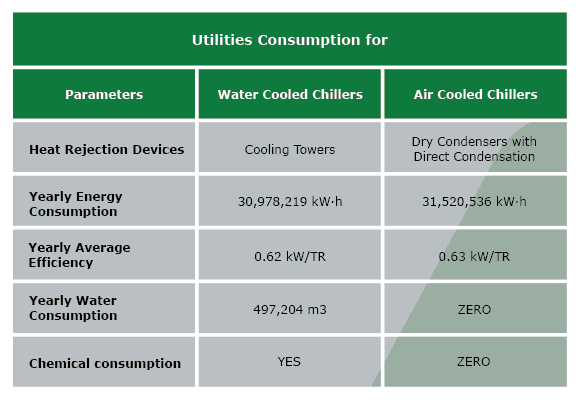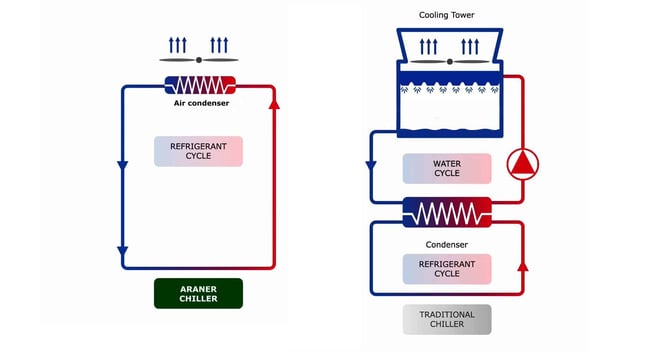The role of a district cooling system is to distribute cooling energy from a centralized production plant using an underground pipeline to a district. It is the perfect replacement for older air conditioning systems because of its lower energy consumption, reduced annual maintenance costs, and environmental friendliness among other benefits. Reliable heat rejection methods from ARANER have been influential in the increasing popularity of this solution. Let us talk about two popular ones: Water-cooled and air-cooled condenser systems.
Overview: Water Cooling vs Air Cooling
Water and air are the main heat rejection mediums for air conditioning systems. When water is plentiful and inexpensive, a water-cooled system, often involving a cooling tower, becomes the most efficient option. If water is unavailable or expensive, air-cooled systems become preferable. ARANER has a wide range of heat rejection systems for all applications. The solutions offer state-of-the-art technology that suits all environments and other requirements.
Comparison of Water-Cooled and Air-Cooled Systems
Which is the better system for district cooling? It is not that easy to answer this question. A thorough comparison of the system is necessary. This post covers three angles namely installation, maintenance and operating cost.
1. Installation
Why does location feature so prominently when installing both systems? The reason is that failing on this aspect can lead to a perpetual recirculation problem in water-cooled systems. For a tower sited in an awkward position, for instance a hole, it is important to consult Araner for advice from the tower selection stage. Installation of air-cooled systems should be in such a way that no obstruction occurs to airflow on both the air discharge and air intake sides. Avoid placing the condenser near a wall or ceiling to prevent air obstruction.
2. Maintenance
Air cooled heat rejection systems are almost maintenance free. Only sporadic periodic cleaning of air condenser coils might be needed if the air-cooled system is operating in a dirty environment in order to avoid the fouling. If fouling is accumulated, your system will develop higher operating discharge pressure, which may increase power consumption by the chiller. Water-cooled systems also have operation and maintenance issues; although it mostly depends on the quality of water used and surrounding conditions. Does it contain a lot of solids and bacteria? Biocides are popular for controlling bacteria growth. Ozone, being a powerful oxidizer, can also help reduce this biological problem. When water evaporates from a cooling tower, it leaves behind all its solid matter. The only way to deal with this problem is to add water to the tower periodically to compensate for the lost water in a process which is called blow down. It prevents proliferation of dissolved solids, which may cause a bigger problem in the form of scale and rust formation. Generally, maintenance of this system is much more demanding than for an air-cooled system.
3. Operating Cost
Traditionally, water-cooled chillers are considered to be much more efficient than air cooled chillers and this is correct for most of the cases and for design conditions. Out of the design conditions the dry bulb temperature is reduced a lot, however the wet bulb temperature is not reduced that much. This means that out of the design conditions the difference in efficiency is not that high and might not justify the water consumption. A typical case is Abdali District Cooling in Amman. Although Amman is a very hot city during the day. However at night the dry bulb temperature is reduced a lot even during summer, while the wet bulb temperature is quite constant during the day. With the help of a long-term thermal energy storage the chillers can operate mainly at night with higher efficiency. For this case and similar ones, if we make the study of the DC plant all around the year and not only for design conditions; we can see that the extra electrical consumption of the air cooled option is negligible while the savings in water consumption are very important:
 Fig 1: Utilities Consumption
Fig 1: Utilities Consumption
A few of the factors that make the air cooled systems preferable are as below:
- No city water expenses
- No cooling towers
- No chemicals and waste water (environmental sustainability)
- Maintenance costs are minimized
In summary
Selection criteria of these systems depend on the respective advantages and disadvantages in regards to a district cooling plant. Choose a water-cooled system if water supply is plentiful, ambient air is free of particles and relative humidity is low during the hot season. An air-cooled system is suitable if water supply is inadequate, water supply is unclean and average relative humidity is high during the hot season.

Fig 2: Summary of Comparison between the Two Systems
It appears that there are many considerations to make when choosing between water-cooled and air-cooled systems. With current technological milestones at ARANER, the notion that water-cooled systems are outright more cost effective no longer stands. Air-cooled chillers are making inroads in areas where water conservation is a priority. Your choice of chilled water system therefore largely depends on location of your plant. Do you need advice on which system is more convenient for you? Contact our experts, they will be pleased to guide you through the best solution. At Araner we can help you with Distrct cooling or District Heating solutions.










